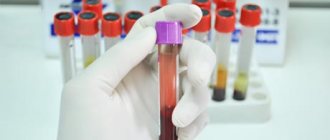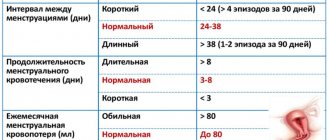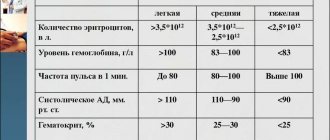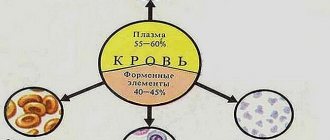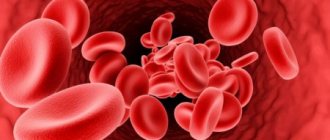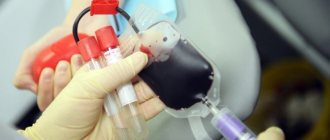0
Author of the article: Marina Dmitrievna
2017.08.14
2 008
Blood analysis
A blood test for coagulation rate according to Sukharev is performed to assess the plasma hemostasis factor.
The ability of blood to clot is an important protective function. Hemostasis includes the ability of blood to remain in a liquid state and the response to vascular damage in the form of stopping bleeding due to two parallel mechanisms: thrombus formation and blood clotting.
Blood collection process in laboratory
Sukharev's coagulation time is a determination of the period of time during which plasma fibrinogen, under the action of enzymes, polymerizes and precipitates in the form of an insoluble fibrin polymer. This test allows you to evaluate the dynamics of coagulation, but does not differentiate its mechanisms.
What is it and what does it affect?
Knowing the viscosity of a person's blood is important. With the help of clotting, the body protects itself, maintains the required blood volume, and prevents its loss.
Coagulability depends on the physicochemical actions of plasma at the molecular level:
- the main role is played by the protein fibrinogen;
- exposure to certain reactions turns into insoluble fibrin, which falls out in the form of very thin lines;
- a dense network of small cells is formed from the threads, in which the formed elements are retained;
- these changes form a blood clot. Gradually it thickens, the wound heals, heals;
- As the clot tightens, a yellowish liquid called serum is formed.
Platelets are a component of plasma that ensures the compaction of a blood clot.
To better understand the coagulation process, it can be compared to the conversion of milk into curd: the process of curdling of casein (milk protein) leads to the release of whey. Gradually the wound heals, the fibrin clot dissolves.
Interesting fact! The test is carried out before an upcoming surgical intervention, pregnancy, or the likelihood of large blood loss.
A blood clotting test is prescribed if the following is suspected:
- pathological liver damage;
- malfunction of the immune system;
- phlebeurysm.
Norm by age (table)
Today there are about 30 types of laboratory blood clotting tests. The material is taken from a vein or finger - depending on the study being performed, it allows you to determine the hemostasis of individual plasma units.
There is a different norm for adults and children. Each test uses its own calculation scheme.
Note! Platelets are the main components of blood, their quantity affects hemostasis. For adults, 150-400 g/l is considered normal, for children – 150-350 g/l.
Standards according to test type
To analyze coagulation by age, the Quick test is used.
Age standards according to Kwik's test
Time tests
The time interval of clotting shows the work of hemostasis. The indicator is useful when a person is sick. To determine it, studies are carried out for which part of the blood is taken.
Clotting times are:
- Primary. Stop blood loss. The vessels narrow and a blood clot forms, blocking the flow of blood.
- Secondary. Coagulation.
When performing analysis, the following rules must be observed:
- Blood sampling occurs before 12 noon, since after this time the readings may be incorrect due to eating or performing strength exercises.
- The day before the procedure, you can eat a light meal. 12 hours before visiting the laboratory you need to completely stop eating.
- You are allowed to drink boiled water.
- If you are taking medications, you need to warn a specialist about this.
The following methods are used to determine hemostasis.
According to Sukharev
Capillary biological fluid is used. Shows enzyme levels. By determining the blood clotting time according to Sukharev, specialists understand how resistant the body is to various hemostasis disorders. In addition, the test demonstrates the general condition of the central nervous system and endocrine system.
- The material is collected on an empty stomach.
- Before the procedure, you can drink a glass of plain water.
- The finger is pricked with a scarifier and the required volume of plasma is taken.
- The test tube is rocked, the time period is noted during which the blood flows down the glass and forms a clot.
Results of checking blood clotting time (BCT) according to Sukharev:
- If the indicator corresponds to the norm, the presence of diseases that negatively affect hemostasis is refuted.
- The clot formed very quickly - this may indicate a high probability of blood clots. An exception is carrying a child, since such an analysis result is a protective function of the body. It can develop while taking oral contraceptives, after the birth of a baby, undergoing surgery, large blood loss, severe burns, and certain diseases.
- A clot does not form for a long time, blood is lost in large portions, health quickly deteriorates, and the possibility of death arises. This condition is provoked by various pathologies and the use of certain medications.
Note! The normal coagulation time for adults is 3-5 minutes, in childhood - 2-5 minutes, expectant mothers - 1.5-2 minutes, elderly people - 1.5-2 minutes (the indicator is explained by the physiological characteristics of the body).
Checking VSK according to Sukharev
According to Morawitz
Popular analysis, gives true results, economical, fast. It is carried out in the morning on an empty stomach. It is necessary to give up alcohol 72 hours, nicotine, caffeine 24 hours before the procedure. It is recommended to drink plain water - it will help you get a more accurate result.
Description of the procedure:
- The collected capillary blood is transferred to a glass slide.
- The stopwatch is started and blood is placed into a glass tube every 30 seconds.
- When fibrin thread appears, the test is stopped. The time is recorded.
In a healthy person, fibrin appears within 5 minutes.
Morawitz technique
According to Duque
Preparation for the procedure is similar. The material for analysis is taken from a finger. Every 15 seconds, apply paper to the puncture until it stops staining with blood. As soon as this happens, the test is stopped. According to the standard, fibrin and clot should form within 3 minutes.
Duque method
Blood clotting time standards according to Sukharev
The process of blood clotting is an important component in the functioning of the body. Keeping blood in a liquid state ensures the normal functioning of the cardiovascular system, and the ability to thicken protects against excessive bleeding and damage to the integrity of blood vessels. To carry out the analysis for VSK, the blood clotting norm according to Sukharev is used
Assessment of coagulation time is carried out in children and adults
To carry out the analysis for MCV, the blood clotting norm according to Sukharev is used. Assessment of coagulation time is carried out in children and adults.
Coagulation factor is used to obtain information about the functioning of the body. A simple test for clotting time according to Sukharev allows you to quickly get the result and draw the appropriate conclusions. The norm in the analysis indicates the absence of violations. Increased or decreased coagulation may be a consequence of illness.
Clotting time testing is prescribed to adults and children in many cases. Before and after surgery, a coagulogram is required. Data on MCV are essential to prevent severe bleeding during surgery and reduce the risk of blood clots. When planning a family, the expectant mother is also examined for various diseases and blood clotting times. Tests are carried out every trimester, and the results are recorded in the patient’s chart.
In addition to the use of sterile equipment and the work of qualified health workers, the doctor gives recommendations to the patient to prepare for the test. If blood sampling standards are violated, the test result will not reflect the patient’s real health status
Particular attention is paid to food and drinks. One day before your visit to the laboratory, you should avoid fatty, spicy or smoked foods, and 10-12 hours before you should not eat at all. Therefore, tests are usually taken in the morning, before breakfast.
Alcohol should be completely avoided 48 hours before donating blood. You are allowed to drink mineral water before the test. Smoking is not recommended for at least 3 hours before the test
Therefore, tests are usually taken in the morning, before breakfast. Alcohol should be completely avoided 48 hours before donating blood. You are allowed to drink mineral water before the test. Smoking is not recommended for at least 3 hours before the test.
5-10 minutes before blood sampling, you should sit down and calm down, normalize your pulse and heartbeat. Preparing children can be more difficult. If the child is nervous, you should distract him and try to calm him down. An agitated state can distort clotting time.
In women and men, as well as in children, blood is drawn from a finger. After puncturing the skin, the first drop is removed with a napkin. Then the sample is taken into a special glass container for analysis to the 30 mm mark. The flask is rocked, tilted from side to side every half a minute, or placed in a Panchenkov apparatus for this purpose. After some time, the blood will begin to clot.
The time for blood clotting according to Sukharev is determined using a stopwatch.
The start and end times of coagulation are taken into account. The normal time for the sample to begin to thicken is 30 to 120 seconds. After this, the blood flow slows down and a clot begins to form. When the sample stops moving inside the glass container, coagulation is considered complete. The norm is between 2 and 5 minutes. Blood clotting according to Sukharev can reveal disturbances in the functioning of the body, but the causes of the disturbances should be sought using additional diagnostic tools.
Why do norm violations occur?
If hemostasis is fast or slow, metabolic processes in the patient’s body are disrupted.
Reasons for increased speed
Accelerated hemostasis signals:
- Liver diseases: cirrhosis, hepatitis, development of a malignant tumor.
- Lack or deficiency of coagulation factors, deficiency of essential proteins.
- Terminal stages of DIC syndrome.
- Intoxication of the body.
- Development of atherosclerosis.
- The presence of an infectious process.
- Congenital genetic abnormalities.
Anticoagulants, antiplatelet agents, and heparin therapy have a negative effect on hemostasis. People using these medications should have their blood clotting checked more often. During treatment with Wafarin, you need to check your INR every month.
Reasons for reduced speed
This phenomenon occurs against the background:
- Hypercoagulation. Manifests itself in the initial stage of DIC syndrome.
- Pathologies accompanied by the likelihood of developing thrombosis. These include arterial hypertension, atherosclerosis, dyslipidemia with high cholesterol levels, thrombosis, varicose veins, thrombophlebitis.
- Long-term use is OK.
- Abuse of alcoholic beverages and nicotine.
- Dehydration.
- Taking corticosteroids for a long time.
Deviation from the norm
If the test result is different from the norm, it means there is a blood clotting disorder. Moreover, both accelerated and delayed hypostasis are considered dangerous .
Delayed hypostasis, or hypocoagulation, requires more time for a blood clot to form. This phenomenon occurs as a result of:
- genetic predisposition (congenital hemophilia);
- leukemia;
- liver dysfunction;
- lack of plasma;
- the last stage of DIC syndrome;
- low hemoglobin level;
- lack of calcium or vitamin K in the body.
Hypocoagulation is dangerous due to the slow formation of a protective crust on the damaged area, as a result of which bleeding may not stop for a long time.
Accelerated hypostasis, or hypercoagulability, means that a blood clot occurs very quickly, and this carries the risk of developing thrombosis in the veins or arteries. This phenomenon occurs due to:
- long-term use of oral contraceptives;
- significant blood loss as a result of injury, surgery or during the postpartum period.
- at the initial stage of DIC syndrome;
- disruption of internal organs;
- poisoning;
- increased platelet production.
When should you get tested?
Checking hemostasis is indicated for:
- planning to conceive a child;
- the presence of autoimmune systematic diseases;
- impaired renal function;
- CVS pathologies;
- the need for surgery and after it;
- diagnosing thrombophilia;
- varicose veins;
- frequent causeless bruising;
- prolonged nasal, uterine and hemorrhoidal bleeding;
- reduced immunity;
- acute inflammation.
A coagulogram is performed on newborns to check the presence/absence of congenital hemostasis pathologies, women at the onset of menopause, expectant mothers and all people over 40 years of age.
The norm for blood clotting according to Sukharev’s method in children is 2-5 minutes
Blood coagulation time according to Sukharev
The analysis is taken using the Sukharev method on an empty stomach or at least three hours after eating. Blood is taken from a finger. No special preparation is needed for the analysis. One feature of this method is that only capillary blood is examined.
The first drop of the patient's blood is removed with a swab. The rest of the portion is placed in a special flask, which swings in both directions. The time when the blood ceases to be liquid is the time of clotting. According to Sukharev’s method, it should be from 30 to 120 seconds. The period from the beginning of fibrin formation to the end of the coagulation process should not exceed five minutes.
The blood clotting time according to Sukharev’s method is an opportunity to determine the stage when fibrinogen, soluble in a normal medium, turns into an insoluble form.
Features in pregnant women
During the process of bearing a child, a woman's body undergoes dramatic changes. The most important thing for him is to preserve and carry the baby normally. Blood volume increases and it begins to circulate faster, which leads to changes in the composition of the plasma. As a result, VSC increases.
Hemostasis affects the course of pregnancy and the likelihood of developing risks during childbirth. To control it, a woman needs to undergo appropriate tests 3 times:
- when a woman registers;
- from 22 to 24 weeks;
- from 34 to 36 weeks.
The level of coagulation will be higher, but the presence of possible deviations from the norm should only be determined by a qualified specialist.
It is important to know! If coagulability is high, the likelihood of a blood clot forming increases, which can block the flow of oxygen and nutrients to organs and the fetus. This leads to problems in the development of the unborn child, the appearance of pathologies and even death.
To protect yourself and your baby from these terrible consequences, a pregnant woman needs to eat fresh fruits and vegetables, drink more fluids, and avoid fried and fatty foods. If dietary nutrition is not enough, anticoagulants are prescribed.
Low coagulability can lead to premature placental abruption and severe bleeding during childbirth. It often develops against a background of reduced immunity. In the absence of adequate treatment, the fetus will develop incorrectly or even die.
What is a coagulogram and how to take a blood test correctly
Coagulogram is a blood test to determine its ability to clot. Too thick blood threatens the formation of blood clots, and subsequently blood clots that block the vessels. Blood cannot deliver oxygen and necessary substances to cells or remove toxins. The functioning of the immune system and thermoregulation are disrupted. Liquid blood causes severe bleeding. In critical situations, this condition can even lead to death.
In order for a coagulogram to show a reliable result, you need to prepare for it:
- The test must be taken on an empty stomach: children under 1 year of age are not fed 30-40 minutes before, 1-5 years old - 2-3 hours before, over 5 years old - 12 hours before;
- half an hour before the test, you need to avoid physical activity and stress, a small child needs to be distracted and calmed down;
- If you are taking blood thinning medications, you should notify your doctor in advance.
- preoperative or postoperative period;
- persistent bleeding;
- hereditary blood diseases;
- autoimmune diseases;
- varicose veins, thrombosis;
- burns, injuries;
- frequent occurrence of hematomas;
- taking medications that affect blood clotting;
- liver pathologies;
- infectious diseases;
- diseases of the cardiovascular system.
This diagnostic technique is prescribed to people in the following situations:
Before carrying out planned surgical interventions, to prevent massive bleeding;
Sickle erythrocytes in the blood
A method has been developed to standardize prothrombin time results, called the international standardized ratio system, so results among laboratories using different test methods can be understood in the same way. The dose of warfarin is changed so that the prothrombin time is longer than usual. Prothrombin times are also maintained longer for people with artificial heart valves, since these valves are more likely to form clots.
For acute and chronic liver diseases;
If bleeding of various kinds occurs that does not stop for a long time;
Before a caesarean section;
If symptoms occur that indicate a decrease in blood clotting ability;
If excessive blood viscosity is suspected.
It could also mean a vitamin K deficiency; liver diseases such as cirrhosis; or that liver injury has occurred. Reasons why you may not be able to take the test or why the results may not be useful include. Has severe diarrhea or vomiting, which causes fluid loss and dehydration. These include many green vegetables such as kale, spinach, collard greens, broccoli and Brussels sprouts. By taking certain herbal products or natural remedies. Drink a lot of alcohol. . Bleeding frequency is most often used to identify qualitative platelet defects such as von Willebrand disease.
This laboratory study is of particular relevance for pregnant women who need constant monitoring of blood clotting rate. This diagnostic event is one of the components of a successful delivery.
What factors influence the result?
In women, results may be slightly abnormal due to menstrual bleeding, use of oral contraceptives, or pregnancy. In such a situation, the doctor may consider the test reading to be normal.
Age also affects VSK. In children, due to the lack of certain substances in the body and the functioning of internal organs, the VSC is low, and this is normal. In older people, blood clots faster because it contains a lot of fibrinogen.
VSC also depends on diet and lifestyle. Fasting and deficiency of nutrients reduce coagulation, increase the likelihood of extensive bleeding and damage to the vascular walls.
Hobbies for extreme sports and physical injuries also have a bad effect on VSC.




